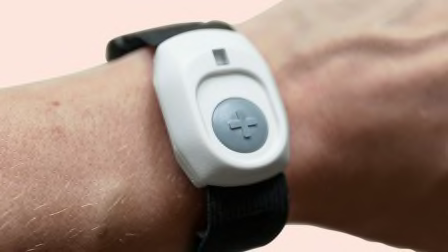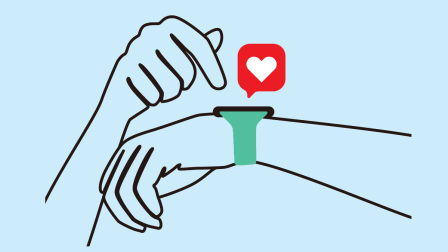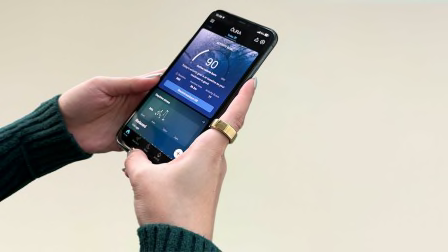The Samsung Galaxy Ring Makes Sleep Tracking Easier, but I Still Prefer My Smartwatch
The new $400 smart ring delivers weeklong battery life. Like the Oura Ring, though, it's less adept at workout tracking.
When you shop through retailer links on our site, we may earn affiliate commissions. 100% of the fees we collect are used to support our nonprofit mission. Learn more.

I’m a longtime smartwatch wearer and a true believer in the benefits of tracking your health data, but I’ve remained a relative stranger to smart rings. So when Samsung introduced the Galaxy Ring, I wasn’t sure what it offered that I couldn’t already get from my watch. Would I get groundbreaking sleep insights? Training data? Would the thing even stay on my hand?
It’s Comfy Enough if You Buy the Right Size
You can’t enjoy the Galaxy Ring’s health insights if you don’t want to wear it. So look and feel matter.
The device is comfortable enough to wear all day, including while sleeping, but I noticed it more than my smartwatch. (That may be because I’m not typically a ring wearer.) It’s fairly lightweight—between 2.3 and 3 grams, depending on ring size, compared with the 4 to 6 grams of the newest Oura Ring—but it’s still bulkier than a typical decorative ring, particularly for women with smaller hands.
It isn’t adjustable, so you need to order the free sizing kit from Samsung or use the kit at a store like Best Buy, which is what I did. The Galaxy Ring comes in nine sizes—5 to 13—but these don’t correlate to traditional ring sizes. I typically wear a size 4, but opted for the 8 here. It slipped on and off easily without feeling precariously loose, including during workouts. Note that the sensors on the ring need to align with the underside of your finger to work properly. There is a little indicator line on the ring to help you ensure it’s facing the right way—and I tried not to absentmindedly spin it throughout the day.
There are three color options: gold, silver, and black. I chose gold, which I think looks the most convincingly like a normal piece of jewelry, but all the colors are neutral and appealing.
Bountiful Battery Life
The Galaxy Ring’s battery life—up to seven days—smokes that of most smartwatches, including the new GalaxyWatch 7 and GalaxyWatch Ultra, which Samsung claims last 40 and 100 hours respectively. (CR doesn’t test smartwatch battery life in our labs, but we do test the accuracy of the step counts and heart rate monitors, among other metrics.) The Galaxy Ring’s battery life is on a par with that of the Oura Ring, which comes with claims of up to a week of juice, and the Ultrahuman Ring Air, which is claimed to last up to six days.
When I purchased the Galaxy Ring on a recent Thursday, it came out of the box with about 97 percent battery. I then wore it day and night for a week. It didn’t need a charge until the following Thursday morning, when I woke up to find it dead. Color me impressed. It’s this sizable battery life that allows for more consistent sleep tracking than you might be able to get with a smartwatch.
When it was finally time to charge, it was back up to 100 percent in less than an hour. I also loved the design for that experience: You place the ring inside a small jewelry box, which can be charged wirelessly or by plugging it into a wall outlet.
A Holistic Look at Health With a Sleep and Energy Score
Now, on to the sleep and health tracking. I’ve always been a decent sleeper. As long as I go to bed at a reasonable hour, I rarely wake up during the night or feel groggy the next day. Because of this (and my smartwatch’s short battery life), I’ve never bothered much with sleep tracking. But over the last week, I pored over my sleep stats, which I found to be the Galaxy Ring’s most interesting health data by far.
Each morning, I consulted the Samsung Health app for the previous night’s Sleep Score—a 1-to-100 value that factors in metrics like how long you slept overall and how long you spent in different sleep stages. I perused my sleeping heart rate, heart rate variability, and blood oxygen levels while snoozing. I also checked my daily Energy Score—a holistic metric that takes into account your sleep quality, as well as the previous day’s activity levels and heart rate—to assess whether I should taper down or ramp up my day’s activity.
While you’d need a professional sleep study to verify that kind of data’s accuracy, it can still be useful, experts say, to notice patterns recorded by at-home sleep tracking devices, make note of any red flags from the ring, and consider tweaking your behavior accordingly.
For example, my overall Sleep Score dipped on the morning I woke up for an early commute to work—sliding from Excellent to Good. It might be worthwhile heading to bed a bit earlier before a day like that, I realized. And after a late Saturday night, during which a few drinks may have been consumed, the Galaxy Ring flagged that my Energy Score had veered into “Needs Attention.” Both my sleeping heart rate and heart rate variability were out of the optimal range. I should make those kinds of nights a once-in-a-while thing, I thought, opting out of the next day’s bike ride.
These aren’t big revelations, of course. I’m well aware that too little sleep and late-night alcohol can take their toll. But by making that toll more visible, the data helped me be more mindful.
This sleep data isn’t unique to the Galaxy Ring. You can get similar insights from many smartwatches and smart rings, but it does play well in the Samsung Health ecosystem used by Galaxy device owners. And, I will say, the impressive battery life of a Galaxy Ring made regular sleep tracking far more feasible for me than a smartwatch does. In my years of owning the Apple Watch SE, I haven’t tracked my sleep once.
It’s Only a Somewhat Helpful Training Partner
The Galaxy Ring isn’t a particularly advanced training partner, especially if you value detailed, accurate metrics on individual workouts.
It will count steps, tell you how many minutes you’ve been active each day and the calories you burned, and log a range of workouts, like runs, bike rides, and swims. But it isn’t equipped with GPS, so you can’t map your routes. And I didn’t love the Galaxy Ring’s automatic workout detection.
Every day, the Galaxy Ring logged at least one, and often multiple, walking workouts without me realizing it, which cluttered up my workout log in the Samsung Health app. (You can delete those workouts, but the missteps still feel annoying.) During a 3-hour hike over the weekend, for example, the Galaxy Ring logged three separate walking workouts, totaling just 61 exercise minutes overall—I’m assuming only when my heart rate was in certain zones. That doesn’t feel useful.
In this regard, the Galaxy Ring is not unlike the Oura Ring. But, for me, a smartwatch outshines a smart ring. When my Apple Watch automatically detects a workout, I’m prompted to either begin or dismiss the activity directly on the watch’s display, and I can easily end the workout exactly when I mean to. My Apple Watch is also really good at automatically pausing workouts, like when I come to a stoplight on my bike. The end result is an exercise log that feels representative of the workouts I actually intended to log.
You can work around this problem on the Galaxy Ring by manually recording workouts—what I should’ve done at the start of my hike—but you have to do that from within the app on your phone, which somewhat defeats the purpose of owning an unobtrusive, set-it-and-forget-it ring.
Is Going Screen-Free Helpful—or a Hindrance?
After a week with the Galaxy Ring, the biggest difference I found between it and my smartwatch is the absence of a display and notifications. On the one hand, it’s really refreshing to own a piece of tech that isn’t constantly vying for my attention. My CR colleague Jodhaira Rodriguez switched from her Apple Watch to an Oura ring mainly to cut back on screen time. And I interacted with the Galaxy Ring only a few times per day to, say, look at the previous night’s sleep performance.
On the other hand, some of that pinging from my smartwatch is truly useful. I like that it regularly prompts me to stand up or get moving in order to close my rings. On the watch display, I can glance at my step count or quickly start a workout at the beginning of an exercise class. With the Galaxy Ring, I had to go to my phone to do all that—and what’s out of sight remains mostly out of mind.




















